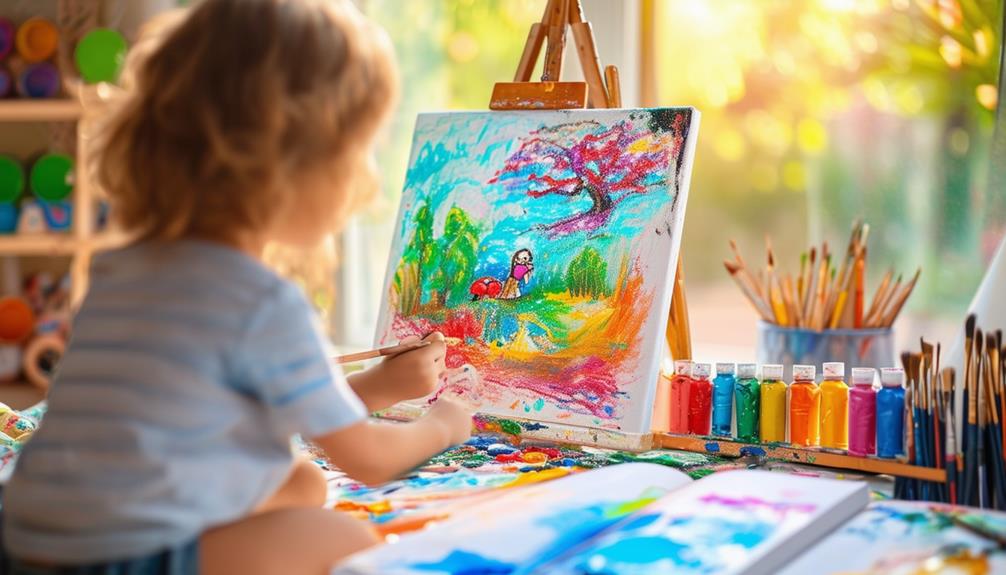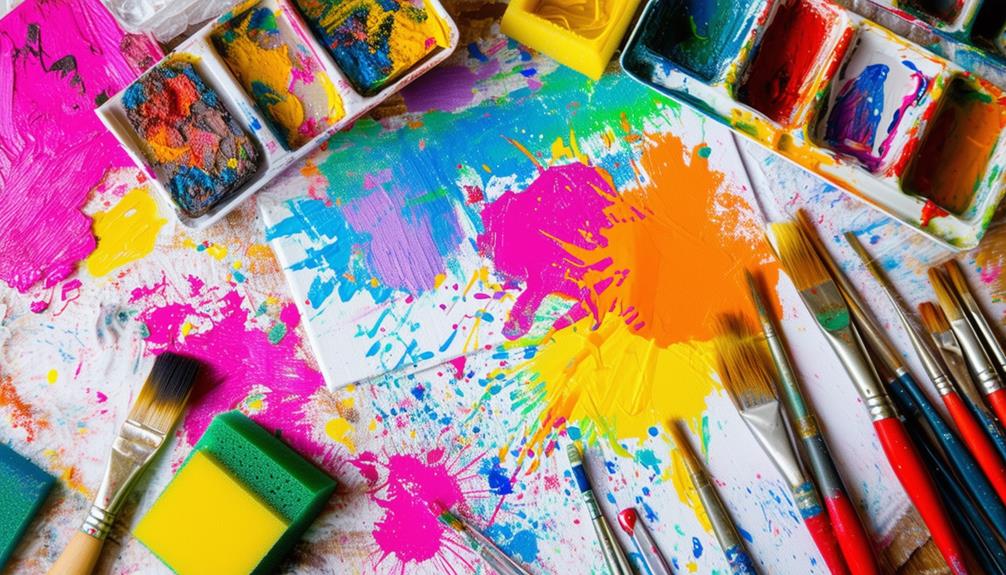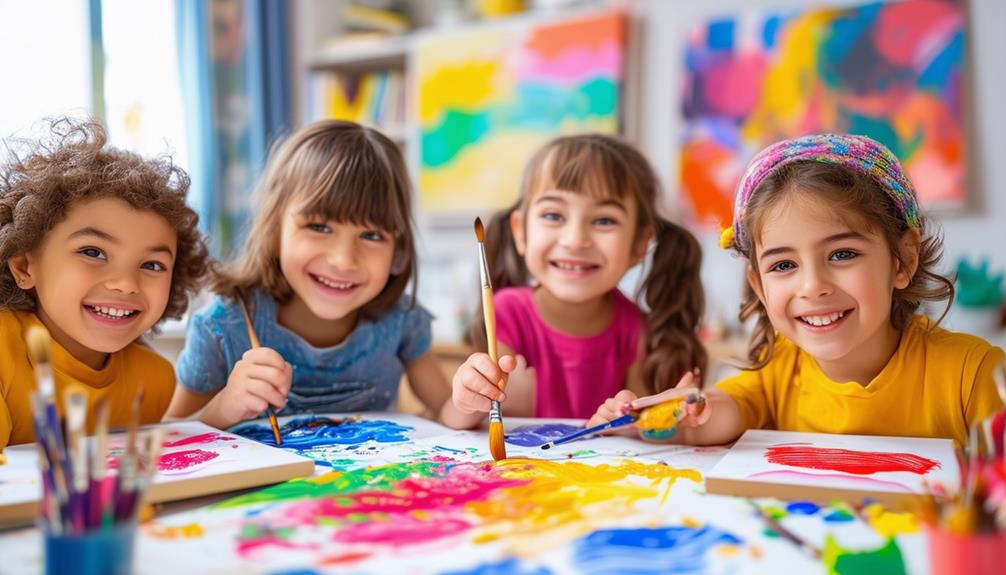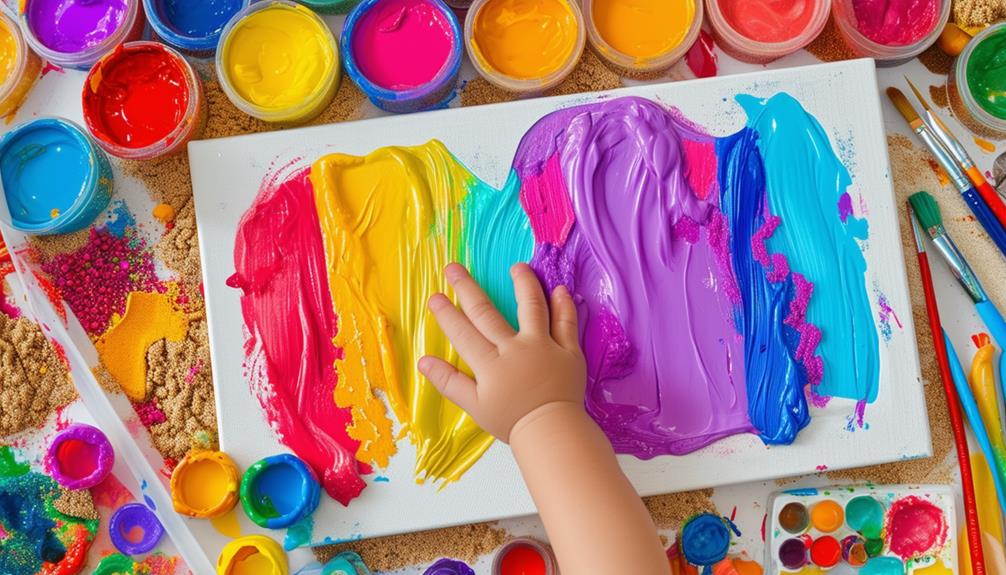The Impact of Painting on Children's Self-Esteem and Confidence
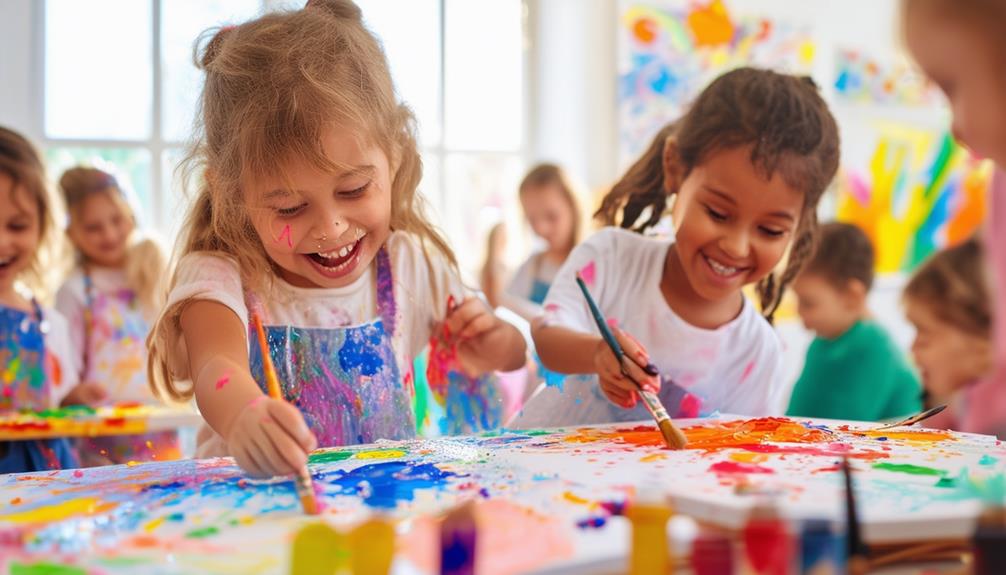
Exploring the impact of painting on children's self-esteem and confidence reveals a compelling link between creativity and personal development. Painting offers kids a unique mode of self-expression, boosting their self-worth and pride. Art classes provide structured environments that encourage safe exploration, fostering a sense of accomplishment and positive reinforcement. Through the artistic process, children develop essential problem-solving skills and resilience. But what specific aspects of painting are most beneficial, and how can they be effectively incorporated into a child's routine?
Importance of Art in Self-Esteem
From an early age, engaging in art can significantly enhance a child's self-esteem. When children immerse themselves in painting, they are given a safe space to express their thoughts and emotions freely. This creative act helps them develop a sense of self-worth and confidence. As they navigate through colors and brushstrokes, children also improve their problem-solving skills and critical thinking abilities.
Art encourages children to take risks and embrace failures, viewing them as essential parts of the creative process. This mindset fosters resilience and a positive self-image. The act of painting itself stimulates the release of dopamine in the brain, leading to feelings of pleasure and satisfaction. This biochemical response further strengthens a child's sense of self, making them feel more accomplished and valued.
Encouraging children to paint can profoundly enrich their self-esteem. Each unique and meaningful piece they create becomes a source of pride, reinforcing their belief in their abilities. By fostering an environment where artistic expression is encouraged, you help children build a stronger, more confident sense of self, laying a foundation for future personal and academic success.
Art Classes for Confidence
Enrolling your child in art classes can significantly boost their confidence and self-esteem. These classes offer a structured environment where children can learn new skills and receive positive feedback, reinforcing their sense of self-worth as their efforts and creativity are recognized and valued.
Art classes encourage children to take creative risks, fostering a sense of accomplishment and enhancing self-image. When kids can express themselves freely without fear of judgment, their confidence naturally grows. These classes become a safe space for children to explore their creativity and take pride in their achievements.
Moreover, the guidance and support from art instructors help children build resilience and problem-solving skills. Overcoming challenges in their artwork translates to a positive self-perception in other life areas. Beyond teaching artistic techniques, art classes equip children with critical life skills, contributing to their overall well-being.
Science Behind Art
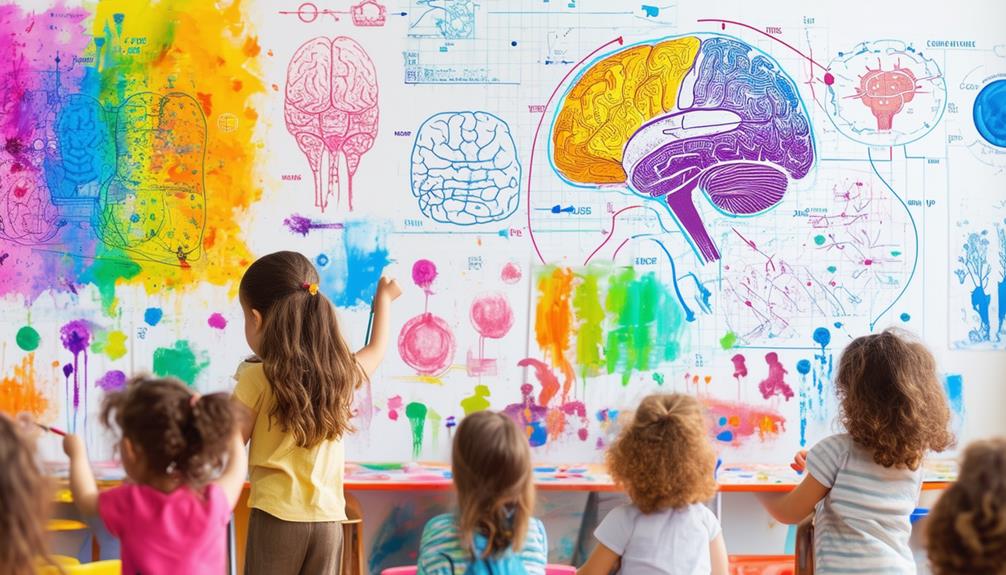
Understanding the science behind art reveals how painting can profoundly influence a child's development and self-esteem. When children engage in painting, their brains' reward centers activate, releasing dopamine, which fosters feelings of pleasure and satisfaction. This natural boost can elevate their mood and reduce stress, creating an optimal environment for growth.
Painting is more than a recreational activity; it's a powerful tool for cognitive development. It allows children to visually express their emotions, thoughts, and experiences, promoting self-awareness. Through the creative process, kids enhance their problem-solving skills and critical thinking abilities, essential for academic success and personal growth.
Here are four key benefits of painting for children:
- Improved Cognitive Skills: Painting stimulates brain activity, enhancing memory and concentration.
- Enhanced Problem-Solving Skills: Children learn to think creatively and resolve artistic challenges.
- Boosted Self-Esteem: Completing a painting bolsters confidence and provides a sense of achievement.
- Emotional Expression: Art offers a safe outlet for expressing complex emotions and experiences.
Incorporating painting into your child's routine can lead to better cognitive development and a stronger sense of self. Understanding the science behind art underscores how this simple activity can make a significant difference.
Encouraging Artistic Expression
To harness the benefits of painting, it's crucial to encourage children to explore their artistic expression. Through painting, children find a unique way to express feelings that might be challenging to articulate with words. This non-verbal outlet helps them process complex emotions and translate them into visual art, significantly enhancing their emotional well-being.
When children paint, they immerse themselves in creativity, experimenting with different colors, shapes, and ideas. This freedom fosters a sense of accomplishment and pride in their work. Each completed painting can boost their self-esteem, making them feel more capable and confident. Regular painting sessions can build a positive self-image as they witness their skills grow and evolve.
Moreover, painting can enhance a child's overall well-being by providing a sense of calm and focus. It requires attention and patience, helping them develop resilience and perseverance. When children see their artistic expression valued and respected, it reinforces their confidence and motivates them to continue exploring their creativity. By supporting their artistic endeavors, you contribute to their self-esteem and emotional health.
Practical Art Activities
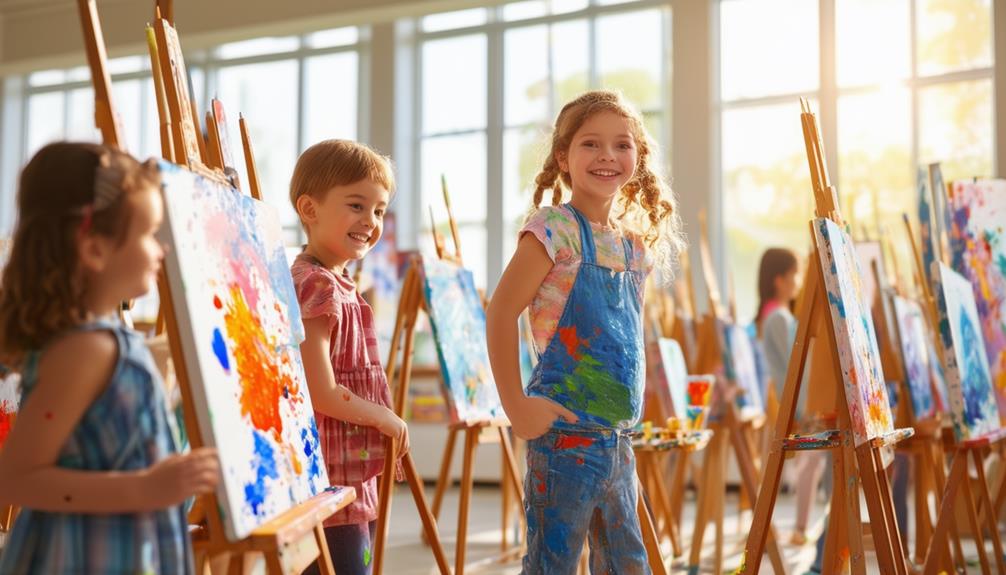
Engaging children in guided drawing, visual journaling, and collage making helps them discover their creativity and build self-esteem. These practical art activities allow kids to express their thoughts and emotions uniquely. By setting goals and celebrating their artistic achievements, you nurture their confidence and self-awareness.
Guided Drawing Techniques
Guided drawing techniques offer children a structured approach to enhance their artistic abilities and boost their self-esteem. By following detailed instructions, kids gain confidence in their drawing skills and a clear pathway to follow, fostering a sense of accomplishment and success essential for their self-esteem.
Integrating guided drawing techniques provides children with tools to express themselves creatively while learning new skills. Key advantages include:
- Skill Development: Children improve fine motor skills, attention to detail, and spatial awareness.
- Confidence Building: Completing a drawing successfully strengthens a child's confidence and sense of achievement.
- Clear Guidance: Step-by-step instructions make drawing approachable for all skill levels.
- Creative Expression: Children can express their unique ideas within a structured framework, making the creative process enjoyable and rewarding.
Visual Journals Benefits
Building on the structured approach of guided drawing, visual journals provide children with a personal space for daily artistic expression and emotional exploration. Through maintaining a visual journal, kids can use art to reflect on their feelings and experiences, fostering self-awareness and emotional intelligence.
Visual journaling is not limited to drawing; it is a holistic practice that enhances creativity, problem-solving, and critical thinking skills. In art classes, encouraging children to use their journals daily allows them to track their artistic progress and growth over time. This ongoing practice can boost their confidence as they witness tangible improvements in their skills and self-expression.
| Benefit | Description |
|---|---|
| Emotional Discovery | Offers a safe space to examine and express emotions. |
| Self-Awareness | Enhances understanding of personal thoughts and feelings. |
| Skill Development | Boosts creativity, problem-solving, and critical thinking. |
As children use art to convey their inner world, they become more adept at recognizing and articulating their emotions. This not only strengthens their self-esteem but also equips them with tools to navigate life's challenges. By incorporating visual journals into your teaching methods, you provide a valuable resource for both emotional and artistic development.
Collage Making Ideas
Collage making is a dynamic and hands-on activity that allows children to express their creativity by combining various materials and images. This versatile art form helps kids develop essential skills by exploring different textures, colors, and shapes to create unique and personal artworks. Engaging in collage making fosters experimentation and problem-solving as children decide how to arrange and layer different elements.
To get started, consider these collage ideas:
- Nature Collage: Collect leaves, flowers, and small twigs. Arrange and glue them onto a piece of paper to create a natural, textured artwork.
- Magazine Mash-Up: Cut out images and words from old magazines. Mix and match to create humorous or thought-provoking scenes.
- Fabric and Paper Fusion: Use scraps of fabric along with colored paper to add a tactile dimension to your collage.
- Story Collage: Create a visual story by combining images and drawings that tell a narrative.
These activities not only help children develop their artistic skills but also teach them to transform mistakes into artistic elements, promoting resilience and adaptability. Additionally, they will experience a sense of accomplishment and pride as their ideas come to life in visually appealing ways.
Benefits of Art Education
Art education offers a multitude of benefits that significantly enhance children's development and well-being. Engaging in artistic activities boosts children's self-esteem and sense of accomplishment, as creating something unique fosters pride and confidence in their abilities. This elevated self-esteem is vital for their overall growth, enabling them to face challenges more effectively.
Moreover, art education instills perseverance and a strong work ethic in children. They learn to see projects through from start to finish, thereby enriching their critical thinking and problem-solving skills. Additionally, participating in art activities enhances cognitive development by fostering creativity, improving hand-eye coordination, and enhancing spatial recognition.
Different aspects of art education offer specific benefits, as outlined below:
| Benefit | Description | Impact on Children |
|---|---|---|
| Self-Esteem Enhancement | Creating unique art pieces | Increases pride and confidence |
| Perseverance | Completing art projects | Develops a strong work ethic |
| Cognitive Development | Activities improving hand-eye coordination | Enhances spatial recognition and creativity |
| Communication Skills | Expressing ideas through art | Improves emotional intelligence and articulation |
| Academic Achievement | Complementing STEM subjects | Supports well-rounded education and personal growth |
Emotional Expression Through Art
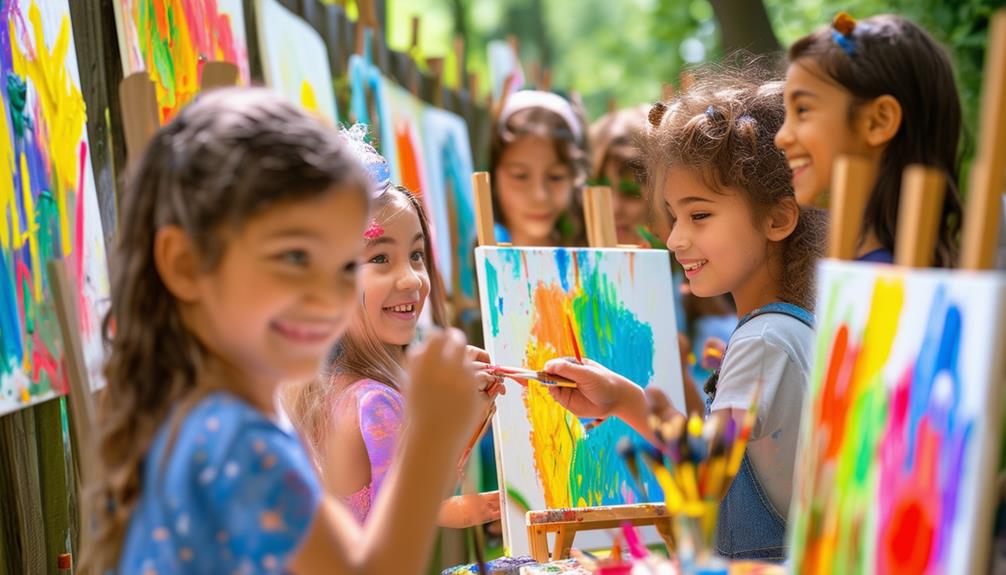
Painting offers children a powerful avenue for expressing their emotions and experiences visually. When kids pick up a paintbrush, they're not merely creating art; they're communicating feelings that words might not fully capture. This form of expression aids in processing and managing complex emotions, providing them with relief and understanding.
Engaging in painting activities also promotes the development of motor skills and critical thinking. As children handle brushes and colors, they enhance their fine motor skills. Moreover, deciding which colors to use and what to paint stimulates their critical thinking, enabling them to make choices, solve problems, and think creatively.
Key benefits of emotional expression through painting include:
- Emotional Release: Children can safely and constructively release frustrations, fears, and joys.
- Boosted Self-Esteem: Creating unique art gives them a sense of accomplishment and pride.
- Improved Communication: Painting helps them articulate thoughts and feelings they might struggle to verbalize.
- Better Insight into Self and Others: Exploring their inner world helps them understand their emotions and develop empathy for others.
In essence, painting is not just about creating art; it's about fostering emotional growth and self-awareness.
Impact on Mental Health
Painting helps reduce stress levels in children, offering a calming effect that enhances their emotional well-being. Engaging in creative activities allows kids to express their feelings healthily, improving self-awareness and emotional regulation. These benefits foster a stronger sense of self and better mental health over time.
Reducing Stress Levels
Engaging in creative activities like painting can significantly reduce stress levels in children by providing a healthy outlet for their emotions. When kids paint, they express themselves non-verbally, which allows them to release pent-up feelings. This process can lower cortisol levels, the stress hormone, leading to a sense of relaxation and calmness.
Here are four reasons why painting helps reduce stress levels in children:
- Mindfulness: Painting requires focus on the present moment, promoting mindfulness and reducing anxiety.
- Emotional Release: It offers a safe space for kids to express their emotions, decreasing negative feelings.
- Improved Mood: Studies indicate that painting can enhance overall well-being and mood by creating a positive emotional experience.
- Therapeutic Benefits: As a form of art therapy, painting has been shown to alleviate stress, boost self-esteem, and increase confidence and empowerment.
Improving Emotional Well-Being
Engaging in art activities like painting provides children with a powerful outlet for self-expression, significantly enhancing their emotional well-being and mental health. Through the creative process, children find a safe space to express their emotions, which helps alleviate stress and anxiety. Painting allows them to explore their inner thoughts and feelings, fostering emotional intelligence and self-awareness.
Participating in painting activities not only elevates children's mood but also contributes to their overall well-being. The act of painting encourages relaxation and mindfulness, which can lead to improved mental health. By concentrating on their artwork, children practice self-care, building resilience and coping skills for life's challenges.
Moreover, painting offers children a sense of accomplishment. Completing an art piece boosts their confidence and promotes a positive self-image. Research indicates that engaging in art can enhance cognitive function, making it a valuable therapeutic tool for emotional well-being. So, the next time your child picks up a paintbrush, remember that they are not just having fun—they are also nurturing their mental health and emotional well-being.
Long-Term Effects
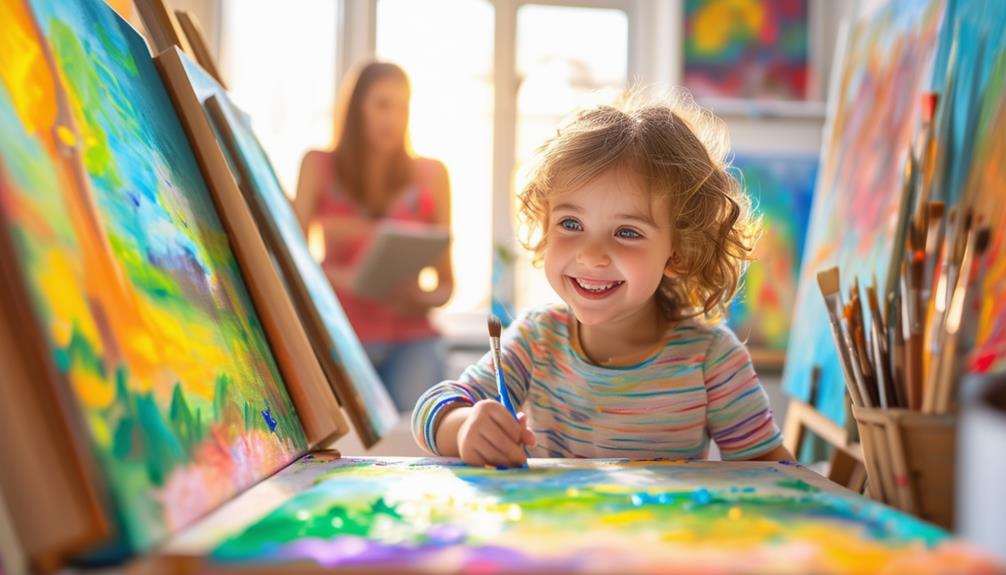
Painting plays a crucial role in fostering children's self-esteem and resilience, benefits that extend well into adulthood. Through painting, children develop a growth mindset, learning to embrace challenges and view mistakes as opportunities for learning. This mindset encourages them to express their ideas more freely and confidently, contributing to long-term personal development.
The long-term effects of painting are significant. First, children who regularly engage in painting often carry a strong sense of self-worth into their adult lives. Second, the ability to explore and understand their emotions through painting enhances their emotional intelligence. Third, consistent engagement in painting fosters a lifelong passion for creativity, serving as a source of joy and fulfillment. Finally, the resilience built through artistic expression equips children to face life's challenges with confidence.
In summary, the long-term benefits of painting include:
- Strengthened self-worth and confidence: Reinforces belief in one's abilities.
- Enhanced emotional intelligence: Improves the ability to understand and manage emotions.
- Lifelong creative passion: Artistic activities continue to bring happiness.
- Greater resilience: Better equips individuals to handle setbacks.

